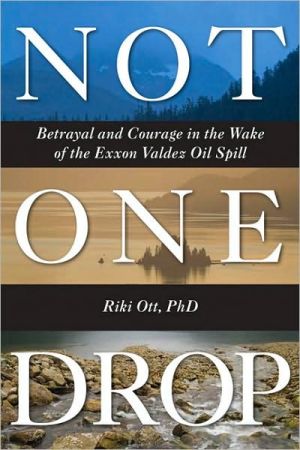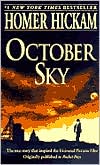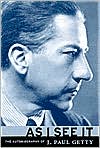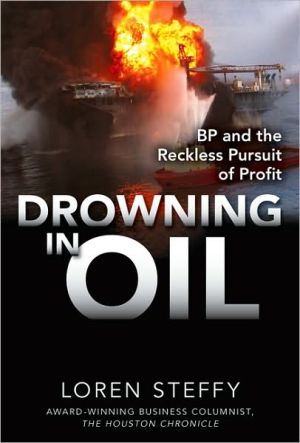Not One Drop: Betrayal and Courage in the Wake of the Exxon Valdez Oil Spill
In the early 1970s, Alaska Senator Ted Stevens promised Cordova fishermen "not one drop" of oil would be spilled in Prince William Sound from proposed tanker traffic and the trans-Alaska pipeline project. Fishermen knew better. Spanning nearly 40 years, Not One Drop is an extraordinary tale of ordinary people who take on the world's richest oil companies and most powerful politicians to protect Prince William Sound from oil accidents.\ Author Riki Ott, a rare combination of commercial salmon...
Search in google:
In the early 1970s, Alaska Senator Ted Stevens promised Cordova fishermen "not one drop" of oil would be spilled in Prince William Sound from proposed tanker traffic and the trans-Alaska pipeline project. Fishermen knew better. Spanning nearly 40 years, Not One Drop is an extraordinary tale of ordinary people who take on the world's richest oil companies and most powerful politicians to protect Prince William Sound from oil accidents.Author Riki Ott, a rare combination of commercial salmon "fisherma'am" and PhD marine biologist, describes the firsthand impact of this broken promise when the Exxon Valdez oil spill decimated Cordova, Alaska, a small commercial fishing community set in 38,000 square miles of rugged Alaska wilderness.Ott illustrates in stirring fashion the oil industry's 20-year trail of pollution and deception that lead to the tragic 1989 spill and delves deep into the disruption to the fishing community for the next 10 years. In vivid detail, she describes the human trauma coupled inextricably with that of the Sound's wildlife and its struggle to recover.Contrasting hard-won spill prevention and response measures in the Sound to dangerous conditions on the trans-Alaska pipeline, Ott critically examines shifts in scientific understanding of oil spill effects on communities and ecosystems, exposing fundamental flaws in governance and the legal system. Her varied background, professional training, and activist heart lead readers confidently and clearly through the maze of laws, back-story, and government red tape as large as that of the five billion dollar lawsuit itself, instilling a new-found sense of understanding of this environmental tragedy. Publishers Weekly Ott, a former Prince William Sound fisherman and longtime activist around the Exxon Valdez Alaska oil spill of 1989, pours plenty of passion into this exhaustive account of the financial and psychological toll on the residents of Cordova, the town most affected by the disaster. Her book is a scathing indictment of Exxon's take-no-prisoners legal roadblocks. She enumerates the full horror of the spill's aftermath: the 1989 loss of $50 million in fishery revenue, a botched cleanup effort, the onslaught of oil-company lobbyists and continuing fish habitat degradation. Ott focuses on Cordova's struggle to rebuild a sense of community while coping with personal bankruptcies and failing marriages, and covers the legal skirmishing for compensation for the more than 3,000 fishermen who filed claims, closing with a melancholy coda following the Supreme Court's decision to reduce the original jury award against Exxon from more than $5 billion to about $500 million-"devastating news" for those "whose lives entered a state of turmoil some 19 years ago." Though Ott's narrative is often bogged down with too much detail, she covers an enormous amount of ground with engaging humanity. (Nov.)Copyright © Reed Business Information, a division of Reed Elsevier Inc. All rights reserved.
NOT ONE DROP\ Betrayal and Courage In the Wake of the Exxon Valdez Oil Spill \ \ By Riki Ott \ Chelsea Green Publishing\ Copyright © 2008 Riki Ott\ All right reserved.\ ISBN: 978-1-933392-58-5 \ \ \ \ Chapter One\ A PLACE TO STAND \ 1986\ * * *\ "If my mother could see me now, she'd kill you!" Danny glared at me from across our towline, stretched taut and spitting beads of water as it disappeared over the bow of the Ambergris into the churning sea.\ It was our fifth salmon opener on the Copper River Flats. A strong storm surge had sucked us into the dreaded breaker patch on the west side of Grass Island. The other end of our one precious net-all that we had been able to afford-was hard aground on the beach, sanding down fast. We were trying to tow it off. Flying spume hurled by a screaming fifty-knot wind stung our faces. Behind us, thunderous breakers as tall as two-story houses collapsed with a woof! of air that shuddered our fiberglass hull. Our diesel engine whined and strained in full reverse, as we dodged steep walls of water.\ Suddenly, a breaker reared up directly behind us. It lifted our five-ton, twenty-seven-foot boat, light as a feather. We surged forward, surfing straight down the wave face. We shot past our towline. At the base of the breaker, the pointed bow of the Ambergris dug into the water. The boat broached violently, rolling on her starboard rail. Almost over. Almost. As I clung to the net reel, I could see Danny's boots dangling in the air as he hung on to the front helm. The hissing white furry-foam of the spent breaker was only inches from my head on the other side of the rail.\ Then, miraculously, the Ambergris found its center and righted itself. Danny and I crashed to the deck, then scrambled up and stared into each other's eyes, searching for some security, something to say that we were all right.\ "That would have been fun in a kayak!" Danny yelled over the screaming wind.\ "That would have been fun on a windsurfer!" I shot back.\ There was a loud thudding noise. The Ambergris shuddered violently and its engine died. The towline was wrapped in our propeller. We were dead in the water and each wave pushed us steadily toward the beach. My stomach clenched.\ We held each other's gaze. Who would have the lifesaving idea to get us out of this mess this time? Each twenty-four-hour fishing period had turned into an epic adventure during which quick wits, steady nerves, and good luck had saved us to fish another day.\ "Hand me that knife," Danny shouted, pointing to the knife taped to the base of the net reel for emergencies. He tied it to his kayak float vest and carefully worked his way around to the stern, balancing on a narrow rail on a wildly bucking boat. He ducked out of sight on the transom, then pounded on the hull, giving me the signal to raise the outdrive unit.\ I leaped onto the fish holds, through the cabin door, and pressed the tilt button, counting the seconds. After six, Danny pounded again. Enough! Through the open cabin door, I watched the lumpy seas against the steady shoreline and felt them pitch and roll our boat. Time slowed to a crawl.\ More pounding! Danny had cleared the towline from the propeller. I lowered the unit and fired up the engine. The Ambergris shook and clattered from a bent prop as we rode the seas back to the end of our net, catching the towline and making it fast to a cleat.\ Then we saw the other end. About a third of our 900-foot long net was sanded down on the beach. We looked at each other, then, remembering the advice given to us by one sage Flats veteran, we simultaneously yelled, "It's only a piece of string! Cut it!"\ We left our only net to its fate as we worked our way out of the jaws of the breaker patch and to a safe anchorage in the Grass Island channel.\ We found our net the next day during the closure, stretched its full three football fields of length on the beach about two miles from the anchorage. During our walk down the beach, we found a boneyard of broken hulls and pieces of other boats that had not survived the breaker patch. Wordlessly, we shook the sand and stiff fish carcasses out of our net.\ Then we hatched a plan. We cut our only net into three pieces and, with the help of another couple who had stayed out for the closure, we carried each shackle of gear, weighing close to 200 pounds, across the soft sand dunes to the anchorage. Three times we made the trip through the glaucous-winged gull colony with scores of birds pelting us with oily droppings, with the driftwood yoke biting into taut shoulder muscles, and with feet sinking deep into loose sand. Three times. Then we sewed our net together and, at high tide, we reeled it back onto our boat.\ As we motored into the Cordova harbor three days after the fishing period had ended, Danny said, "I don't think we should do anything, and I don't think we should do that very fast."\ This incident proved to be our rite of passage into the fleet of 500 fishermen. Our tenacity-and the fact that we had "he-manned" our net across sand too soft to land a plane-had impressed a tough crowd. Friendships grew as acquaintances, even strangers, started giving us sound advice. Our local knowledge increased exponentially. We began to believe we might actually live through our first season.\ Spring Reds and Kings on the Copper River Flats\ From mid-May through mid-June we fished for king salmon and red salmon on the Copper River Flats, a seventy-mile strip of remote coastline to the south and east of Cordova. The Flats are the seam between the 700,000-acre Copper River Delta and the Gulf of Alaska-wide-open ocean all the way to Hawaii. The Delta sprawls at the base of the Chugach and Wrangell-Saint Elias Mountains, a region containing the greatest coastal relief on Earth with some peaks towering nearly three miles high. The largest network of ice caps and glaciers outside of the Polar Regions and Greenland constantly worry the range, slowly eroding the peaks like giant slow-moving bulldozers. This mountain range is the greatest source of sediment into the Pacific Ocean from all of the Americas.\ The Delta is built from sand and silt-mountain dust dumped when the Copper River abruptly slows its headlong rush and empties into the sea. At the frayed seaward edge of the Delta, the sea and river carves and reworks the sand into a maze of braided sloughs. Long shore and tidal currents take the sediment load and mold it to form a series of barrier islands like long running stitches that separate the wetlands from the sea.\ There are no navigational charts for this area. It is impossible to pin the constantly shifting barrier islands to a spot on a map. The National Oceanic and Atmospheric Administration (NOAA) nautical charts simply end at Cape St. Elias on the eastern side of the Flats and start again at Hinchinbrook Island on the western side, leaving a big hole in between. The hole is filled by the highly coveted and often hard-won "local knowledge."\ Our most precious tidbit of local knowledge was shared by the fisherman who had patiently taught us to hang our first net. It was a single sheet of paper, showing a U-2 satellite photo of the Flats. Notes were scribbled across the map-wavy lines for breaker patches, "X"s for sunken boat wrecks that would snag fishing gear, little anchors for safe deep holes tucked up behind the islands, and local names for fishing spots, some with warnings like "The Mouse Trap-stay away!" The bar crossings-the deepwater channels between the barrier islands-were also labeled with notes. "Strawberry-AVOID." "Grass Island-west side only."\ Danny and I added to our local knowledge by following other fishermen-"seagulling" they called it-to learn the safest commute to the fishing grounds for small boats. "The Can Channel" eliminated the need to go across Strawberry Bar, which claims lives nearly every year. Young, cut spruce marked the channel like poles in a downhill ski racecourse. I plugged the spruce pole locations into our Loran as Danny fought to keep the Ambergris steady in the wash of wakes from thirty boats all racing along at top speed. The "Racetrack" was so narrow that boats zoomed along single file, swerving and weaving around the buoys that marked the course. These channels were passable only around high tide.\ The tides added a whole other dimension to fishing. Four times a day there are huge tidal exchanges that completely change the landscape. Channels full of water at high tides empty in the space of a few hours. Mean sea level can drop by up to eighteen feet during semimonthly spring tides around the new or full moon, leaving behind acres of flat sand-and sometimes fishing boats stranded like monuments until the next tidal cycle. One fisherman's boat, the Curlew, grounded so far out of the channel on a spring high tide that it stayed there on the sand flats for six weeks until the tides were high enough to float it again.\ We were warned about the spring storms. The trough of low pressure that forms in the Gulf of Alaska each winter begins to disintegrate in May. But even in dying, the trough can birth vicious storms-cyclones-within hours, too quickly to be detected by the NOAA weather satellites that sweep over the area every six hours. The year before, when I had crewed, one killer storm sprang upon the fleet unannounced. It went from flat calm to blowing over 100 knots within an hour. The storm caught the fleet fishing near Cape Saint Elias. Half a dozen men were lifted from sinking boats by Coast Guard helicopters. Four days later, a couple of the abandoned boats were found drifting by Hinchinbrook Entrance about 100 miles west of the Cape.\ Fishermen turn these harrowing incidents into funny stories, which are swapped in town during closures. Paul Swartzbart, who had been at the Cape, joked, "When I tried to pick fish from my net, the wind tore at my rain gear and flapped the hood against my face so hard it about knocked me out. Then it pulled my jacket right up over my head. I couldn't see a darn thing! I think if it's blowing over eighty, just forget rain gear. Pick in the nude!"\ Fishing the Flats is tricky business. Your competition one minute could be your rescuer the next. Ric Schultz has fished the breakers longer than most in the fleet. Most people who dared to fish the breakers where the fish ran hard would have a bad scare, feel lucky to survive, and learn to fish elsewhere. The town has more than its share of widows. But Ric fishes the beguiling area known as the "Mouse Trap" year after year, despite having spent the better part of one afternoon in the surf, then on the beach, while breakers mauled his overturned boat. Ric had to charter a plane to get the dog, which refused to get on the rescue boat. During one closure he told a story: "First, this guy corks me and steals my fish, and then he expects me to rescue him when his boat flips!" Ric did. Such rescues would be considered heroics elsewhere, but on the Flats it is just another story told in town during closures.\ Fishing couples are rare. When we delivered our fish to waiting tenders on the ebb tides, we were often asked, "Who's the skipper? A boat can only have one skipper!" But on the Ambergris, neither of us knew enough to be skipper, so we took turns. The agonizing decision of where to fish could be worth thousands of dollars-or maybe your life.\ Whoever's turn it was to be skipper would head for a spot and set the gear, quickly backing the boat to lay out the net, while the deckhand or crew guided armfuls of flying cork line, lead line, and web off the spinning reel to prevent a backlash and ripped gear. Then the skipper would watch the net for snags and dangerous drift. One could cover quite a distance on a hard flood or ebb. The crew could fix a bite to eat or grab a quick nap.\ When the skipper called to pull the set, the roles immediately swapped. Whoever had made the set now acted as crew to pick it, pawing through the nylon strands, rubber-gloved fingers flying, to untangle the silvery supple salmon from the web. Meanwhile, the new skipper scanned for a position for the next set or prepared to run back a couple miles to the old spot. This way we managed to fish around the clock, twenty-four hours or thirty-six hours, or however long the fishing opener was.\ I quickly learned that one of the main fringe benefits of fishing is watching wildlife. Orcas patrol the outside beaches for unwary seals and sea lions, which in turn hunt for salmon. Noisy glaucous-winged gulls hover in tight flocks and take turns plopping into the water after silvery hooligan. Dark lithe jaegers chase clumsy gulls to steal their fish. Graceful white Arctic terns, swift and fast, make clownish puffins seem even more ungainly. Small charcoal storm petrels flit and fuss near the sea surface, completely at home with the waves. I learned to watch for shearwaters as harbingers of storms. These big, dark, graceful seabirds appear just before big blows like vultures circling to find a kill. When storm winds follow, shearwaters play at the turbulent sea surface, gliding just above lumpy waves and swells.\ It is small wonder that marine insurers consider the Copper River Flats to be the most dangerous salmon fishery in the world, but I loved it all-the moods of the sea, the energy of the storms, the dynamics of the fishing fleet, my partner, and the creatures going on about their business. I felt connected to something way bigger than myself, something real.\ Closures and Community\ During closures we commuted back to town-four to six hours or more if the weather was bad or the tide was wrong. Once back in town we switched from tide time to town time. We delivered iced fish to the seafood processors, scrubbed the fish holds, and took showers at the Copper River Fishermen's Cooperative, "The Co-op," where we sold our fish. We usually pulled the net off the boat onto the dock and stretched it its full twenty-three-foot depth, stacking the cork line and lead line at either end. I mended the net while Danny tinkered with the engine, hydraulics, or other pieces of equipment that needed endless attention. It was a division of labor that suited both of us. I liked working with the mending needle and gossamer twine, weaving new strands of web where harbor seals or Steller sea lions had torn fish from the net. I found I grew quickly frustrated in the confined, stinky engine room space with the rusty too- hard-to-turn nuts. It didn't seem to bother Danny. We ate out, always alert for rumors of who caught fish and where. We slept on our boat in the harbor to save money and keep an eye on who was doing what.\ One of the best ways to figure out what was going on in town and out on "the fishing grounds" was at a Co-op salmon barbeque. It was one of the few places where highliners, rookies, tendermen, net hangers, and net menders all mingled-and everyone was in a good mood. The Co-op was always looking to recruit members, so the barbeques were frequent.\ The five-year-old company was owned and operated by fishermen who believed that bled and iced fish would fetch a quality price. The Co-op usually matched "grounds price," the competitive price offered by the other seafood processors to fishermen on the fishing grounds. Then in the spring, the Co-op kicked back to its members any profits from the previous season's fish sales. The rest of the fleet tolerated the Co-op with its disproportionate number of "eggheads" or highly educated (most townspeople thought overeducated) folks, because it usually drove up the grounds price for the benefit of all. The Co-op's pioneering niche market efforts led to Copper River reds and kings becoming a household name in Japan, where the fish commanded premium prices.\ Wives and children usually came to the barbeques. That made a world of difference for me. Fishing was mostly a world full of men. I didn't realize how wearying that was until one day when I was grocery shopping. I was standing in the produce section looking over the lettuce when I suddenly realized that I felt completely relaxed and peaceful. I froze so as not to chase the feelings off and focused on my surroundings. Women were all around, chatting away to each other-and not about boat engines, fish, or weather. After that, I made a point to befriend women in town.\ (Continues...)\ \ \ \ \ Excerpted from NOT ONE DROP by Riki Ott Copyright © 2008 by Riki Ott. Excerpted by permission.\ All rights reserved. No part of this excerpt may be reproduced or reprinted without permission in writing from the publisher.\ Excerpts are provided by Dial-A-Book Inc. solely for the personal use of visitors to this web site. \ \
Foreword ixPreface xiiiAcknowledgments xviiIntroduction xixAbbreviations xxiiiPart 1 Promises (1986-1989) 11 A Place to Stand 32 Politics of Oil 173 Prelude to Disaster 29Part 2 Betrayal (1989-1993) 394 Taking a Stand 415 Virtual Reality 616 Tricks of the Trade 807 When Right Makes Might 1048 As Bad as It Gets 119Part 3 Courage (1994-1999) 1419 Decisions 14310 Stepping-stones 16211 Gaining Ground 17912 Moving On 196Part 4 New Beginnings (2000-2008) 21113 Leaving the Oil Age 21314 "A New Species of Trouble" 23315 A New Consciousness 253Epilogue 267Timeline 271Notes 281Glossary 316About the Author 318Index
\ Publishers WeeklyOtt, a former Prince William Sound fisherman and longtime activist around the Exxon Valdez Alaska oil spill of 1989, pours plenty of passion into this exhaustive account of the financial and psychological toll on the residents of Cordova, the town most affected by the disaster. Her book is a scathing indictment of Exxon's take-no-prisoners legal roadblocks. She enumerates the full horror of the spill's aftermath: the 1989 loss of $50 million in fishery revenue, a botched cleanup effort, the onslaught of oil-company lobbyists and continuing fish habitat degradation. Ott focuses on Cordova's struggle to rebuild a sense of community while coping with personal bankruptcies and failing marriages, and covers the legal skirmishing for compensation for the more than 3,000 fishermen who filed claims, closing with a melancholy coda following the Supreme Court's decision to reduce the original jury award against Exxon from more than $5 billion to about $500 million-"devastating news" for those "whose lives entered a state of turmoil some 19 years ago." Though Ott's narrative is often bogged down with too much detail, she covers an enormous amount of ground with engaging humanity. (Nov.)\ Copyright © Reed Business Information, a division of Reed Elsevier Inc. All rights reserved.\ \








